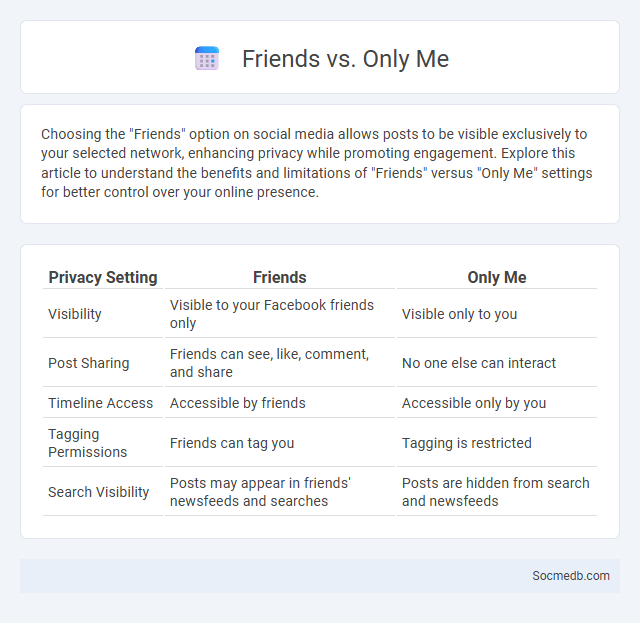
Photo illustration: Friends vs Only Me
Choosing the "Friends" option on social media allows posts to be visible exclusively to your selected network, enhancing privacy while promoting engagement. Explore this article to understand the benefits and limitations of "Friends" versus "Only Me" settings for better control over your online presence.
Table of Comparison
| Privacy Setting | Friends | Only Me |
|---|---|---|
| Visibility | Visible to your Facebook friends only | Visible only to you |
| Post Sharing | Friends can see, like, comment, and share | No one else can interact |
| Timeline Access | Accessible by friends | Accessible only by you |
| Tagging Permissions | Friends can tag you | Tagging is restricted |
| Search Visibility | Posts may appear in friends' newsfeeds and searches | Posts are hidden from search and newsfeeds |
Understanding Facebook's Privacy Settings
Mastering Facebook's privacy settings empowers you to control who can see your posts, profile information, and activity. Customize audience options like Public, Friends, or Specific Groups to enhance your security and personalize your online presence. Regularly reviewing these settings helps protect your personal data from unauthorized access and tailor your social media experience to your comfort level.
What Does "Friends" Privacy Setting Mean?
The "Friends" privacy setting on social media platforms restricts your content visibility exclusively to people you have accepted as friends, preventing strangers or casual followers from seeing your posts. This option enhances account security by limiting access to personal information and updates, fostering a controlled digital environment. Users can usually customize who qualifies as a friend, ensuring that only trusted connections engage with their shared content.
Exploring the "Only Me" Option
The "Only Me" option on social media platforms allows users to restrict post visibility exclusively to themselves, enhancing privacy control and personal content management. This setting is crucial for saving drafts, personal reflections, or sensitive information without sharing it publicly or with friends. Understanding how to effectively use the "Only Me" privacy feature can improve user experience by balancing content security with selective sharing on networks like Facebook, Instagram, and LinkedIn.
Comparing "Friends" vs "Only Me" Settings
Friends" settings on social media allow content to be shared exclusively with a selected network, enhancing privacy while enabling interaction through likes and comments. In contrast, the "Only Me" setting restricts visibility solely to the user, providing maximum confidentiality for personal posts or drafts. Choosing between these options impacts user control over audience reach and engagement on platforms like Facebook and Instagram.
How Privacy Settings Impact Your Online Presence
Privacy settings on social media directly influence the control you have over your personal information and the visibility of your content, which shapes your online reputation. Adjusting these settings determines who can access your posts, photos, and personal details, reducing risks of data misuse and unwanted exposure. Enhanced privacy controls contribute to a safer online presence by limiting access to trusted connections and minimizing unauthorized tracking.
Adjusting Visibility for Posts and Photos
Adjusting visibility settings for social media posts and photos enables users to control who can view their content, enhancing privacy and audience targeting. Platforms like Facebook and Instagram offer options such as public, friends-only, or custom lists to tailor visibility based on user preferences. Regularly reviewing and updating these settings ensures optimal content sharing aligned with privacy and engagement goals.
Pros and Cons of Restrictive Privacy Settings
Restrictive privacy settings on social media protect Your personal information by limiting access to your profile, reducing the risk of data breaches and unwanted contact. These settings, however, can hinder social interaction and content sharing, potentially decreasing engagement and networking opportunities. Balancing privacy with connectivity is crucial to ensure You maintain control over Your online presence while still benefiting from social media's social and professional advantages.
Best Practices for Customizing Privacy
Customizing your privacy settings on social media platforms empowers you to control who sees your personal information, posts, and activity. Review each platform's privacy controls frequently to adjust visibility, manage friend lists, and disable location tracking for enhanced security. You should also limit data sharing with third-party apps to minimize exposure of your digital footprint.
Protecting Personal Information Online
Protecting your personal information online requires using strong, unique passwords for each social media account and enabling two-factor authentication to add an extra layer of security. Regularly reviewing privacy settings and being cautious about the amount of personal data shared can prevent unauthorized access and identity theft. Avoid clicking on suspicious links or accepting friend requests from unknown sources to safeguard your digital presence.
Tips for Regularly Reviewing Privacy Settings
Regularly reviewing your social media privacy settings protects your personal information from unauthorized access and potential cyber threats. Platforms like Facebook, Instagram, and Twitter frequently update their privacy policies and features, so staying informed ensures optimal control over your data visibility. Set reminders to audit your friend lists, app permissions, and location settings to maintain your online privacy effectively.
 socmedb.com
socmedb.com